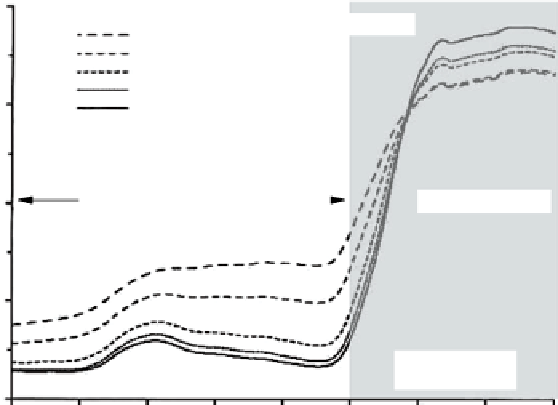Agriculture Reference
In-Depth Information
0.4
red edge
0 kg N / ha
20 kg N / ha
40 kg N / ha
60 kg N / ha
80 kg N / ha
N fertilizer applied on March 13,
spectral recording on May 5
0.3
nitrogen effect on chlorophyll
red edge infl. points
0.2
0.1
nitrogen effect on
leaf-area-index
0.0
450
500
550
600
650
700
750
800
850
wavelength in nm
blue
near-infrared
green
yellow
red
Fig. 9.19
Reflectance of winter-rye at time of second top-dressing depending on the amount of
nitrogen spread 7 weeks earlier. The
curves
are based on natural illumination and
vertical view
directions
. The red edge inflection points are not to scale (From Reusch
1997
and Heege et al.
2008
, altered)
Two approaches have been used for detecting suitable narrow wavebands or
optical indices. The first approach has been to rely on established, well known opti-
cal indices and to find out, which of these are the best indicators of the nitrogen
supply. So the selection occurs among
standard indices
that originally just were
The second approach is based on the assumption that - regarding especially
nitrogen - these standard indices may disregard or miss the information that can
be obtained from very discrete parts of the spectral curves. Consequently, ini-
tially full spectra without any interruptions are processed with the objective of
finding discrete narrow bands that are the most sensitive to the nitrogen supply.
These wavelengths from suitable narrow sections may in a second step be com-
bined to
new indices
, which then can be regarded as
special nitrogen indices
for
agricultural crops.
Remote sensing from satellites mainly is done via standard indices, whereas for
proximal sensing from farm machines increasingly new indices supply the signals.
There are reasons for these differences.
The remote sensed signals from satellites hardly are used solely for sensing the
nitrogen status of crops, especially until now not on a site-specific field basis.
Predominantly, the remote sensed signals are employed on a whole field basis or for
even wider areas for
e.g.
biomass sensing or crop classification. However, if the








